Land-Use Change and Future Water Demand in California’s Central Coast
Abstract
1. Introduction
2. Materials and Methods
2.1. State Variables and Scale
2.2. Model Formulation
2.3. Land Change Transitions Targets
2.4. Perennial Transition Probabilities
2.5. Adjacency & Spatial Multipliers
2.5.1. Urbanization
2.5.2. Agricultural Expansion
2.5.3. Conversions to Perennial—Historical and Projected
2.6. Water Demand
2.7. Land Use and Land Cover Scenarios
2.8. Model Validation
3. Results
3.1. Projected Land Use and Land Cover Change
3.2. Projected Future Water Demand
Potential Changes in Groundwater Basin Overdraft
4. Discussion and Conclusions
4.1. Projected Water Demand Trends
4.2. Land Use and Water Use Sustainability Implications
4.3. Assessment of Historic Policy Impacts
4.4. Future Directions
Supplementary Materials
Author Contributions
Funding
Acknowledgments
Conflicts of Interest
References
- Stonestrom, D.A.; Scanlon, B.R.; Zhang, L. Introduction to special section on Impacts of Land Use Change on Water Resources. Water Resour. Res. 2009, 45. [Google Scholar] [CrossRef]
- Foley, J.A. Global Consequences of Land Use. Science 2005, 309, 570–574. [Google Scholar] [CrossRef] [PubMed]
- Diffenbaugh, N.S.; Swain, D.L.; Touma, D. Anthropogenic warming has increased drought risk in California. Proc. Natl. Acad. Sci. USA 2015, 112, 3931–3936. [Google Scholar] [CrossRef] [PubMed]
- Williams, A.P.; Seager, R.; Abatzoglou, J.T.; Cook, B.I.; Smerdon, J.E.; Cook, E.R. Contribution of anthropogenic warming to California drought during 2012–2014. Geophys. Res. Lett. 2015, 6819–6828. [Google Scholar] [CrossRef]
- Ellis, E.C.; Klein Goldewijk, K.; Siebert, S.; Lightman, D.; Ramankutty, N. Anthropogenic transformation of the biomes, 1700 to 2000. Glob. Ecol. Biogeogr. 2010, 19, 589–606. [Google Scholar] [CrossRef]
- Januchowski-Hartley, S.R.; Holtz, L.A.; Martinuzzi, S.; Mcintyre, P.B.; Radeloff, V.C.; Pracheil, B.M. Future land use threats to range—Restricted fish species in the United States. Divers. Distrib. 2016. [Google Scholar] [CrossRef]
- Klausmeyer, K.R.; Shaw, M.R. Climate Change, Habitat Loss, Protected Areas and the Climate Adaptation Potential of Species in Mediterranean Ecosystems Worldwide. PLoS ONE 2009, 4, e6392. [Google Scholar] [CrossRef]
- Hansen, A.J.; Rotella, J.J. Biophysical Factors, Land Use, and Species Viability in and around Nature Reserves. Conserv. Biol. 2002, 16, 1112–1122. [Google Scholar] [CrossRef]
- Fischer, J.; Lindenmayer, D.B. Landscape modification and habitat fragmentation: A synthesis. Glob. Ecol. Biogeogr. 2007, 16, 265–280. [Google Scholar] [CrossRef]
- Los Huertos, M.; Gentry, L.E.; Shennan, C. Land Use and Stream Nitrogen Concentrations in Agricultural Watersheds Along the Central Coast of California Available. Sci. World J. 2001, 1, 1–8. [Google Scholar] [CrossRef][Green Version]
- Charbonneau, R.; Kondolf, G.M. Land use change in California, USA: Nonpoint source water quality impacts. Environ. Manag. 1993, 17, 453–460. [Google Scholar] [CrossRef]
- Scanlon, B.R.; Reedy, R.C.; Stonestrom, D.A.; Prudic, D.E.; Dennehy, K.F. Impact of land use and land cover change on groundwater recharge and quality in the southwestern US. Glob. Chang. Biol. 2005, 11, 1577–1593. [Google Scholar] [CrossRef]
- Konikow, L.F.; Kendy, E. Groundwater depletion: A global problem. Hydrogeol. J. 2005, 13, 317–320. [Google Scholar] [CrossRef]
- Lotze-Campen, H.; Müller, C.; Bondeau, A.; Rost, S.; Popp, A.; Lucht, W. Global food demand, productivity growth, and the scarcity of land and water resources: A spatially explicit mathematical programming approach. Agric. Econ. 2008, 39, 325–338. [Google Scholar] [CrossRef]
- García-Ruiz, J.M.; López-Moreno, J.I.; Vicente-Serrano, S.M.; Lasanta–Martínez, T.; Beguería, S. Mediterranean water resources in a global change scenario. Earth Sci. Rev. 2011, 105, 121–139. [Google Scholar] [CrossRef]
- Calder, I.R.; Reid, I.; Nisbet, T.R.; Green, J.C. Impact of lowland forests in England on water resources: Application of the Hydrological Land Use Change (HYLUC) model. Water Resour. Res. 2003, 39. [Google Scholar] [CrossRef]
- Baker, T.J.; Miller, S.N. Using the Soil and Water Assessment Tool (SWAT) to assess land use impact on water resources in an East African watershed. J. Hydrol. 2013, 486, 100–111. [Google Scholar] [CrossRef]
- Wilson, T.S.; Sleeter, B.M.; Sherba, J.; Cameron, D. Land-use impacts on water resources and protected areas: Applications of state-and-transition simulation modeling of future scenarios. AIMS Environ. Sci. 2015, 2, 282–301. [Google Scholar] [CrossRef]
- Wilson, T.S.; Sleeter, B.M.; Cameron, D.R. Future land-use related water demand in California. Environ. Res. Lett. 2016, 11, 054018. [Google Scholar] [CrossRef]
- California Department of Food and Agriculture. California Agricultural Statistics Review—2017–2018; California Department of Food and Agriculture: Sacramento, CA, USA, 2018; pp. 1–121. [Google Scholar]
- Brandt, J.; Sneed, M.; Rogers, L.L.; Metzger, L.F.; Rewis, D.; House, S. Water Use in California, 2014; U.S. Geological Survey, California Water Science Center: Sacramento, CA, USA, 2015.
- Cooley, H. Agricultural Water Conservation and Efficiency Potential in California; Natural Resources Defense Council, Pacific Institute: Oakland, CA, USA, 2014; p. 7. [Google Scholar]
- Maupin, M.A.; Kenny, J.F.; Hutson, S.S.; Lovelace, J.K.; Barber, N.L.; Linsey, K.S. Estimated Use of Water in the United States in 2010; U.S. Geological Survey: Reston, VA, USA, 2014; p. 56.
- Grantham, T.E.; Viers, J.H. 100 years of California’s water rights system: Patterns, trends and uncertainty. Environ. Res. Lett. 2014, 9, 084012. [Google Scholar] [CrossRef]
- Dettinger, M.D.; Ralph, F.M.; Das, T.; Neiman, P.J.; Cayan, D.R. Atmospheric Rivers, Floods and the Water Resources of California. Water 2011, 3, 445–478. [Google Scholar] [CrossRef]
- Perrone, D.; Jasechko, S. Dry groundwater wells in the western United States. Environ. Res. Lett. 2017, 12, 104002. [Google Scholar] [CrossRef]
- Barlow, P.M.; Reichard, E.G. Saltwater intrusion in coastal regions of North America. Hydrogeol. J. 2010, 18, 247–260. [Google Scholar] [CrossRef]
- Hanson, R.T. Geohydrology of Recharge and Seawater Intrusion in the Pajaro Valley, Santa Cruzand Monterey Counties, California; U.S. Geological Survey: Reston, VA, USA, 2003; p. 4.
- White, E.; Kaplan, D. Restore or retreat? Saltwater intrusion and water management in coastal wetlands. Ecosyst. Health Sustain. 2017, 3, e01258. [Google Scholar] [CrossRef]
- Berg, N.; Hall, A. Increased Interannual Precipitation Extremes over California under Climate Change. J. Clim. 2015, 28, 6324–6334. [Google Scholar] [CrossRef]
- Swain, D.L. A tale of two California droughts: Lessons amidst record warmth and dryness in a region of complex physical and human geography. Geophys. Res. Lett. 2015. [Google Scholar] [CrossRef]
- AghaKouchak, A.; Cheng, L.; Mazdiyasni, O.; Farahmand, A. Global warming and changes in risk of concurrent climate extremes: Insights from the 2014 California drought. Geophys. Res. Lett. 2015, 8847–8852. [Google Scholar] [CrossRef]
- Ault, T.R.; Cole, J.E.; Overpeck, J.T.; Pederson, G.T.; Meko, D.M. Assessing the Risk of Persistent Drought Using Climate Model Simulations and Paleoclimate Data. J. Clim. 2014, 27, 7529–7549. [Google Scholar] [CrossRef]
- Famiglietti, J.S. The global groundwater crisis. Nat. Clim. Chang. 2014, 4, 945. [Google Scholar] [CrossRef]
- Trenberth, K.E.; Dai, A.; van der Schrier, G.; Jones, P.D.; Barichivich, J.; Briffa, K.R.; Sheffield, J. Global warming and changes in drought. Nat. Clim. Chang. 2014, 4, 17–22. [Google Scholar] [CrossRef]
- Famiglietti, J.S.; Lo, M.; Ho, S.L.; Bethune, J.; Anderson, K.J.; Syed, T.H.; Swenson, S.C.; Linage, D.; Rodell, M. Satellites measure recent rates of groundwater depletion in California’s Central Valley. Geophys. Res. Lett. 2011, 38. [Google Scholar] [CrossRef]
- McEvoy, A.; Famiglietti, J.S.; Liu, P.W.; Reager, J.T., II. From Drought to Recovery: A GRACE-Based Assessment of Groundwater Storage Variations in California; American Geophysical Union: Washington, DC, USA, 2017. [Google Scholar]
- Ojha, C.; Shirzaei, M.; Werth, S.; Argus, D.F.; Farr, T.G. Sustained Groundwater Loss in California’s Central Valley Exacerbated by Intense Drought Periods. Water Resour. Res. 2018, 54, 4449–4460. [Google Scholar] [CrossRef] [PubMed]
- Swain, D.L.; Langenbrunner, B.; Neelin, J.D.; Hall, A. Increasing precipitation volatility in twenty-first-century California. Nat. Clim. Chang. 2018, 8, 427–433. [Google Scholar] [CrossRef]
- Leahy, T.C. Desperate Times Call for Sensible Measures: The Making of the California Sustainable Groundwater Management Act. Gold. Gate Univ. Environ. Law J. 2016, 9, 37. [Google Scholar]
- Costa, J. The Groundwater Management Act, California State Assembly Bill 3030, Water Code 10750. 1992. Available online: http://leginfo.legislature.ca.gov/faces/codes_displaySection.xhtml?sectionNum=10750.&lawCode=WATT (accessed on 10 September 2020).
- Machado, M. Groundwater management: State Funding, California State Senate Bill 1938, Water Code Sections 10753.4 and 10795.4. 2002. Available online: http://leginfo.legislature.ca.gov/faces/billNavClient.xhtml?bill_id=200120020SB1938 (accessed on 10 September 2020).
- Costa, J.; Setencich, B. Water Supply Planning, California State Senate Bill 901, Section 65302. 1995. Available online: http://www.leginfo.ca.gov/pub/95-96/bill/sen/sb_0901-0950/sb_901_bill_951016_chaptered.html (accessed on 10 September 2020).
- Costa, J. Land Use and Water Supplies, California State Senate Bill 610, Chapter 643. 2001. Available online: http://www.leginfo.ca.gov/pub/01-02/bill/sen/sb_0601-0650/sb_610_bill_20011009_chaptered.html (accessed on 10 September 2020).
- Kuehl, S.; Machada, M.; Perata, D.; Chan, W.; Goldberg, J.; Pavley, F.; Strom-Martin, V.; Thomson, H. California State Senate Bill 221, Section 11010. 2001. Available online: http://www.leginfo.ca.gov/pub/01-02/bill/sen/sb_0201-0250/sb_221_bill_20011009_chaptered.html (accessed on 10 September 2020).
- Dickinson, R. Groundwater Management, California State Assembly Bill 1739, Section 347. 2014. Available online: http://leginfo.legislature.ca.gov/faces/billNavClient.xhtml?bill_id=201320140AB1739 (accessed on 10 September 2020).
- Pavley, F. Groundwater, Water Code amendment; California State Senate Bill 1168. 2014. Available online: https://leginfo.legislature.ca.gov/faces/billNavClient.xhtml?bill_id=201320140SB1168 (accessed on 10 September 2020).
- Pavley, F. Groundwater, California State Senate Bill 1319, Chapter 348. 2014. Available online: http://leginfo.legislature.ca.gov/faces/billNavClient.xhtml?bill_id=201320140SB1319 (accessed on 10 September 2020).
- Martin, J.N. Central Coast Groundwater: Seawater Intrusion and Other Issues; CA Water Plan Update 2013, Volume 4 Reference Guide; California Water Foundation: Sacramento, CA, USA, 2014; pp. 1–27. [Google Scholar]
- California State Legislature, Water Division 26.5. Water Security, Clean Drinking Water, Coastal and Beach Protection Act of 2002, Water Code 79500–79591, Section 79505.5. 2002. Available online: http://leginfo.legislature.ca.gov/faces/codes_displaySection.xhtml?sectionNum=79505.5&lawCode=WAT (accessed on 10 September 2020).
- U.S. Census Bureau. QuickFacts: Salinas City, California; U.S. Department of Commerce: Washington, DC, USA, 2018.
- State of California, Department of Finance State of California Department of Finance Projections. Available online: http://www.dof.ca.gov/Forecasting/Demographics/Projections/ (accessed on 14 December 2018).
- Sleeter, B.M.; Liu, J.; Daniel, C.J.; Frid, L.; Zhu, Z. An integrated approach to modeling changes in land use, land cover, and disturbance and their impact on ecosystem carbon dynamics: A case study in the Sierra Nevada Mountains of California. AIMS Environ. Sci. 2015, 2, 577–606. [Google Scholar] [CrossRef]
- Sleeter, B.M.; Wilson, T.S.; Sharygin, E.; Sherba, J.T. Future Scenarios of Land Change Based on Empirical Data and Demographic Trends. Earths Future 2017, 5, 1068–1083. [Google Scholar] [CrossRef]
- Sleeter, B.M.; Marvin, D.C.; Cameron, D.R.; Selmants, P.C.; Westerling, L.; Kreitler, J.; Daniel, C.J.; Liu, J.; Wilson, T.S. Effects of 21st century climate, land use, and disturbances on ecosystem carbon balance in California. Glob. Chang. Biol. 2019. [Google Scholar] [CrossRef]
- Wilson, T.S.; Sleeter, B.M.; Cameron, D.R. Mediterranean California’s water use future under multiple scenarios of developed and agricultural land use change. PLoS ONE 2017, 12, e0187181. [Google Scholar] [CrossRef]
- Wilson, T.S.; Sleeter, R.R.; Soulard, C.E.; Sleeter, B.M. Land-Use Threats and Protected Areas: A Scenario-Based, Landscape Level Approach. Land 2014, 3, 362–389. [Google Scholar] [CrossRef]
- Daniel, C.J.; Frid, L. Predicting Landscape Vegetation Dynamics Using State-and-Transition Simulation Models. In Proceedings of the First Landscape State-and-Transition Simulaiton Modeling Conference, Portland, OR, USA, 14–16 June 2011; General Technical Report PNW-GTR-869. U.S. Department of Agriculture, Forest Service: Portland, OR, USA, 2011; pp. 5–22. [Google Scholar]
- Kerns, B.K.; Shlisky, A.J.; Daniel, C.J. Proceedings of the First Landscape State-and-Transition Simulation Modeling Conference, Portland, OR, USA, 14–16 June 2011; United States Forest Service: Washington, DC, USA, 2012.
- Daniel, C.; Frid, L.; Sleeter, B.; Fortin, M.-J. State-and-transition simulation models: A framework for forecasting landscape change. Methods Ecol. Evol. 2016. [Google Scholar] [CrossRef]
- California Department of Water Resources CA Bulletin 118 Groundwater Basins. 2018. Available online: http://atlas-dwr.opendata.arcgis.com/datasets/b5325164abf94d5cbeb48bb542fa616e_0 (accessed on 10 September 2020).
- Homer, C.; Dewitz, J.; Fry, J.; Coan, M.; Hossain, N.; Larson, C.; Herold, N.; McKerrow, A.; VanDriel, J.N.; Wickham, J. Completion of the 2001 National Land Cover Database for the Conterminous United States. Photogramm. Eng. Remote Sens. 2007, 73, 337–341. [Google Scholar]
- Soulard, C.E.; Acevedo, W.; Stehman, S.V. Removing Rural Roads from the National Land Cover Database to Create Improved Urban Maps for the United States, 1992 to 2011. Photogramm. Eng. Remote Sens. 2018, 84. [Google Scholar] [CrossRef]
- LANDFIRE Program LANDFIRE Existing Vegetation Cover. 2001. Available online: https://www.landfire.gov/evc.php (accessed on 22 August 2019).
- National Atlas of the United States. Grayscale Conterminous United States Shaded Relief—200-Meter Resolution; U.S. Geological Survey: Reston, VA, USA, 2005. Available online: https://www.usgs.gov/core-science-systems/national-geospatial-program/national-map (accessed on 10 September 2020).
- California Department of Water Resources Groundwater Sustainability Agency (GSA) Map Viewer. Available online: https://sgma.water.ca.gov/webgis/index.jsp?appid=gasmaster&rz=true (accessed on 8 September 2020).
- California Department of Water Resources Water Districts. Available online: https://data.ca.gov/dataset/water-districts (accessed on 8 September 2020).
- California Department of Conservation Farmland Mapping and Monitoring Program: County Data. Available online: http://www.conservation.ca.gov/dlrp/fmmp/Pages/county_info.aspx (accessed on 8 September 2020).
- California Department of Water Resources Crop Mapping. 2014. Available online: https://data.cnra.ca.gov/dataset/crop-mapping-2014 (accessed on 8 September 2020).
- Corelogic CA Area Parcel Residential and Non-Residential. Available online: https://hifld-geoplatform.opendata.arcgis.com/ (accessed on 17 July 2019).
- Johnson, R.; Cody, B.A. California Agricultural Production and Irrigated Water Use; Congressional Research Service: Washington, DC, USA, 2015; pp. 1–25. [Google Scholar]
- Kroodsma, D.A.; Field, C.B. Carbon Sequestration in California Agriculture, 1980–2000. Ecol. Appl. 2006, 16, 1975–1985. [Google Scholar] [CrossRef]
- Sleeter, R.R.; Acevedo, W.E.; Soulard, C.; Sleeter, B.M.; U.S. Geological Survey, Eastern Geographic Science Center, Gig Harbor, WA, USA. Methods used to parameterize the spatially-explicit components of a state-and-transition simulation model. AIMS Environ. Sci. 2015, 2, 668–696. [Google Scholar] [CrossRef]
- U.S. Geological Survey Protected Areas Database of the United States (PAD-US), Version 1.4 Combined Feature Class. Available online: https://www.sciencebase.gov/catalog/item/5963ea3fe4b0d1f9f059d955 (accessed on 8 September 2020).
- Onsted, J.A.; Chowdhury, R.R. Does zoning matter? A comparative analysis of landscape change in Redland, Florida using cellular automata—ScienceDirect. Landsc. Urban Plan. 2014, 121, 1–18. [Google Scholar] [CrossRef]
- Dieleman, F.; Wegener, M. Compact City and Urban Sprawl. Built Environ. 2004, 30, 308–323. [Google Scholar] [CrossRef]
- Hersperger, A.M.; Oliveira, E.; Pagliarin, S.; Palka, G.; Verburg, P.; Bolliger, J.; Grădinaru, S. Urban land-use change: The role of strategic spatial planning. Glob. Environ. Chang. 2018, 51, 32–42. [Google Scholar] [CrossRef]
- Poelmans, L.; Van Rompaey, A. Complexity and performance of urban expansion models. Comput. Environ. Urban Syst. 2010, 34, 17–27. [Google Scholar] [CrossRef]
- Geneletti, D. Assessing the impact of alternative land-use zoning policies on future ecosystem services. Environ. Impact Assess. Rev. 2013, 40, 25–35. [Google Scholar] [CrossRef]
- Abdolrassoul, S.M.; Clarke, K.C. Guiding SLEUTH Land-Use/Land-Cover Change Modeling Using Multicriteria Evaluation: Towards Dynamic Sustainable Land-Use Planning. Environ. Plan. B Urban Anal. City Sci. 2012, 39, 925–944. [Google Scholar] [CrossRef]
- U.S. Census Bureau 2010 Census Urban and Rural Classification and Urban Area Criteria. Available online: https://www.census.gov/geo/reference/ua/urban-rural-2010.html (accessed on 1 February 2017).
- United States Department of Agriculture (USDA), N.A.S.S. (NASS) USDA, National Agricultural Statistics Service, 2010 California Cropland Data Layer. Available online: http://www.nass.usda.gov/research/Cropland/metadata/metadata_ca10.htm (accessed on 24 July 2014).
- California Department of Water Resources Agricultural Land & Water Use 1998–2010. Available online: https://water.ca.gov/Programs/Water-Use-And-Efficiency/Land-And-Water-Use/Agricultural-Land-And-Water-Use-Estimates (accessed on 8 September 2020).
- Homer, C.G.; Dewitz, J.A.; Yang, L.; Jin, S.; Danielson, P.; Xian, G.; Coulston, J.; Herold, N.D.; Wickham, J.D.; Megown, K. Completion of the 2011 National Land Cover Database for the conterminous United States-Representing a decade of land cover change information. Photogramm. Eng. Remote Sens. 2015, 81, 345–354. [Google Scholar] [CrossRef]
- U.S. Geological Survey USGS Water Use Data for the Nation. Available online: http://waterdata.usgs.gov/nwis/wu (accessed on 8 September 2020).
- Environmental Systems Research Institute ESRI World Terrain Base Map. Available online: http://goto.arcgisonline.com/maps/World_Terrain_Base (accessed on 12 June 2020).
- United States Department of Agriculture 2017 Census of Agriculture: California State and County Data. Available online: https://www.nass.usda.gov/Publications/AgCensus/2017/Full_Report/Volume_1,_Chapter_1_State_Level/California/cav1.pdf (accessed on 8 September 2020).
- Joseph, A. What Clever Grape Growers are Doing to Counter the Drought Crunch. | Cover Collections |. Available online: http://www.montereycountyweekly.com/news/cover_collections/what-clever-grape-growers-are-doing-to-counter-the-drought/article_51032b34-eec2-11e4-b2b9-9ff0de68566c.html (accessed on 22 August 2019).
- Shea, M. Monterey County Farmer Highlight: Water Conservation. Available online: https://www.co.monterey.ca.us/government/departments-a-h/agricultural-commissioner/land-use/monterey-county-farmer-highlight/water-conservation#ag (accessed on 25 November 2019).
- Lobell, D.B.; Field, C.B. California perennial crops in a changing climate. Clim. Chang. 2011, 109, 317–333. [Google Scholar] [CrossRef]
- Kerr, A.; Dialesandro, J.; Steenwerth, K.; Lopez-Brody, N.; Elias, E. Vulnerability of California specialty crops to projected mid-century temperature changes. Clim. Chang. 2018, 148, 419–436. [Google Scholar] [CrossRef]
- County of San Luis Obispo Agriculture Element Revised May 2010. Available online: https://www.slocounty.ca.gov/getattachment/72316c5b-f626-456c-8cd6-e81e6d6baf47/Agriculture-Element.aspxwa (accessed on 8 September 2020).
- State of California. Locally Reported Household Water Shortages for Drought Assistance; Department of Water Resources: Sacramento, CA, USA, 2019. [Google Scholar]
- California Department of Food and Agriculture Benefits of Farmland Conservation in California. Available online: https://www.cdfa.ca.gov/oefi/climate/docs/Farmland-Conservation-in-California.pdf (accessed on 8 September 2020).
- Pierce, G.; Chow, N.; DeShazo, J.R. The case for state-level drinking water affordability programs: Conceptual and empirical evidence from California. Util. Policy 2020, 63, 101006. [Google Scholar] [CrossRef]
- Baird, G.M. Water Affordability: Who’s Going to Pick Up the Check? J. Am. Water Work. Assoc. 2010, 102, 16–23. [Google Scholar] [CrossRef]
- Feinstein, L.; Phurisamban, R.; Ford, A.; Tyler, C.; Crawford, A. Drought and Equity in California; Pacific Institute: Oakland, CA, USA, 2017; pp. 1–80. [Google Scholar]
- Mack, E.A.; Wrase, S. A Burgeoning Crisis? A Nationwide Assessment of the Geography of Water Affordability in the United States. PLoS ONE 2017, 12, e0169488. [Google Scholar] [CrossRef]
- U.S. Department of the Interior. Strategic Plan. for Fiscal Years 2018–2022; U.S. Department of the Interior: Washington, DC, USA, 2018; pp. 1–52.
- Legislative Analyst Office. California’s High. Housing Costs—Causes and Consequences; State of California: Sacramento, CA, USA, 2015; pp. 1–44. [Google Scholar]
- R Core Team. R: A Language and Environment for Statistical Computing; R Foundation for Statistical Computing: Vienna, Austria, 2017. [Google Scholar]

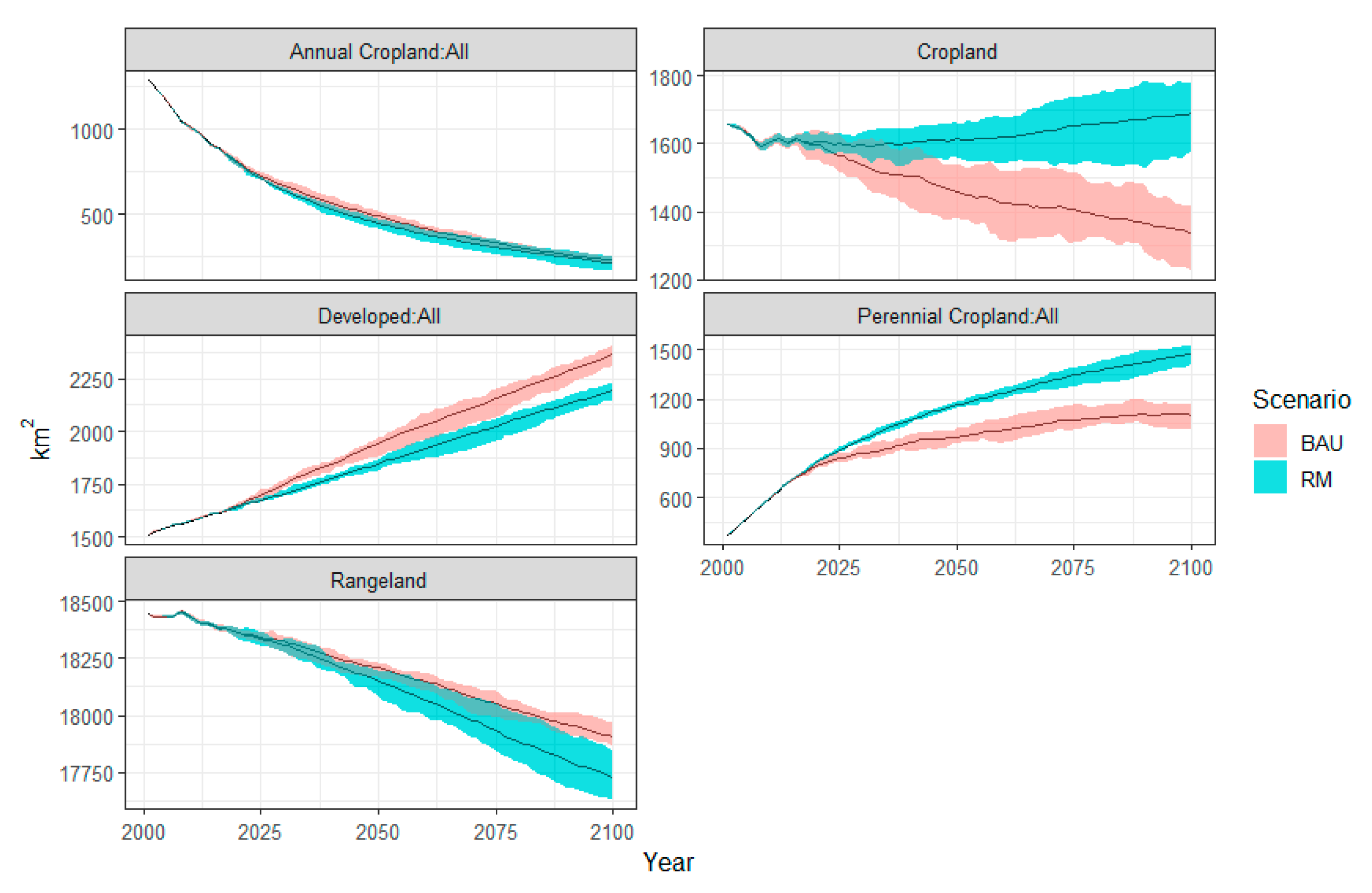
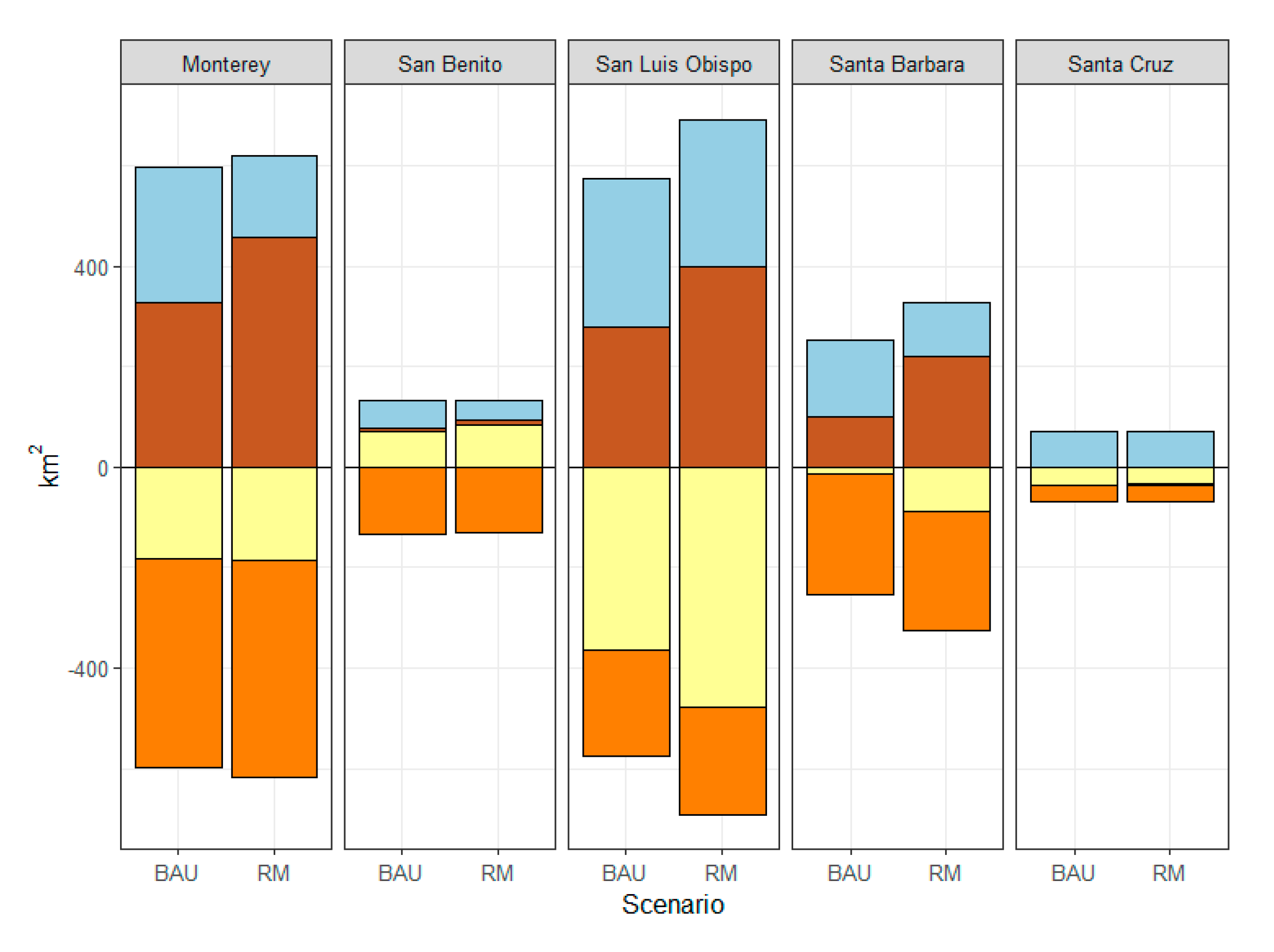
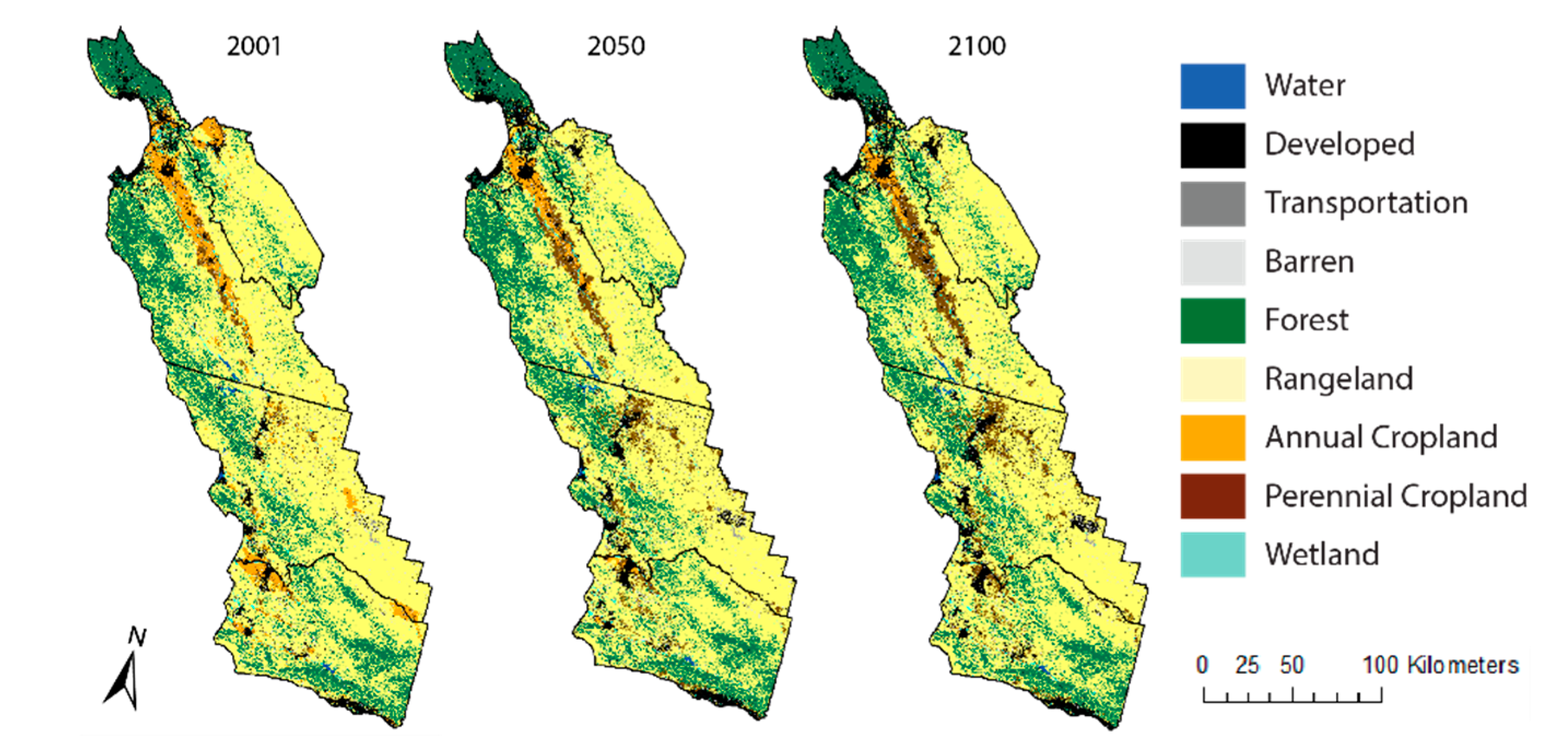
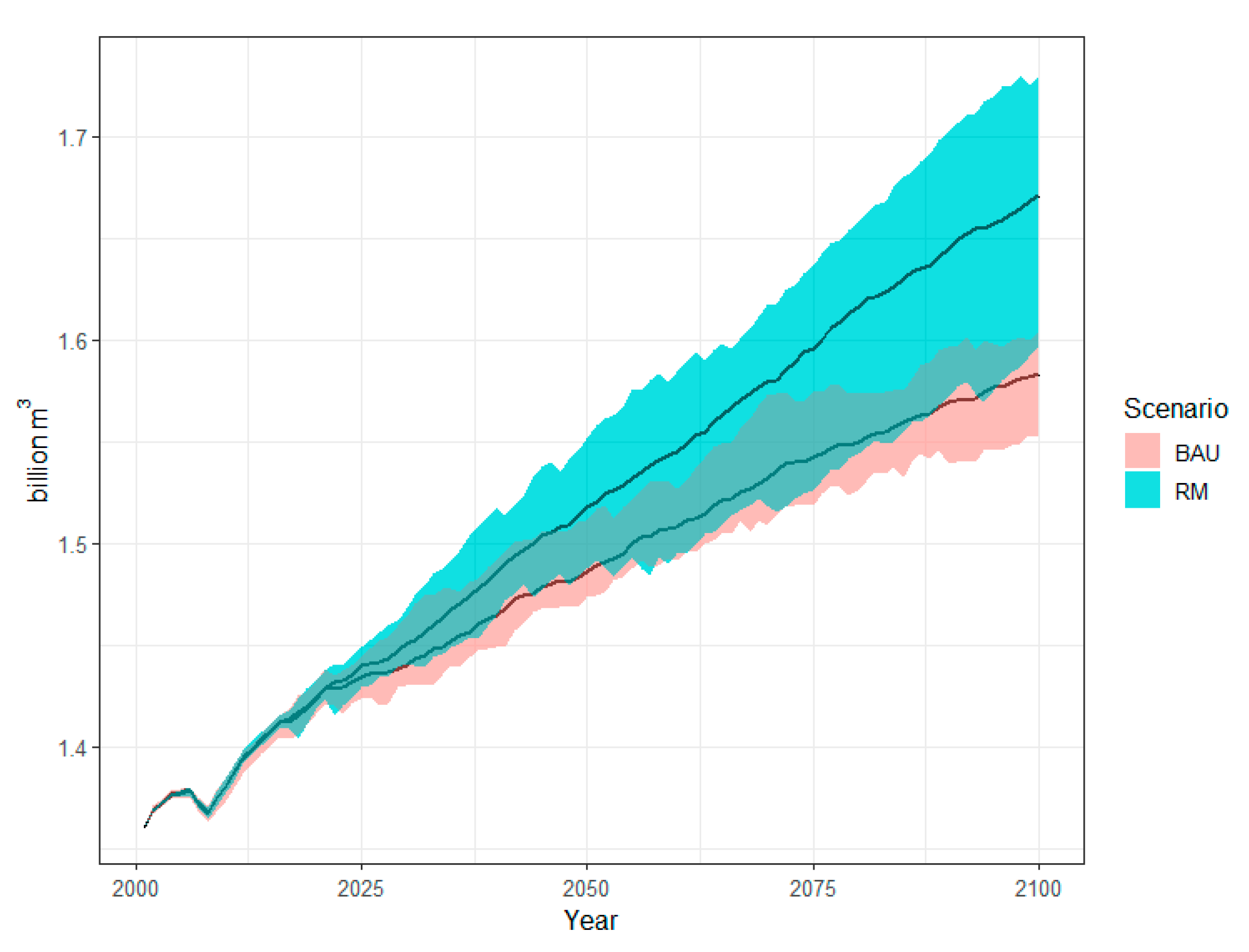
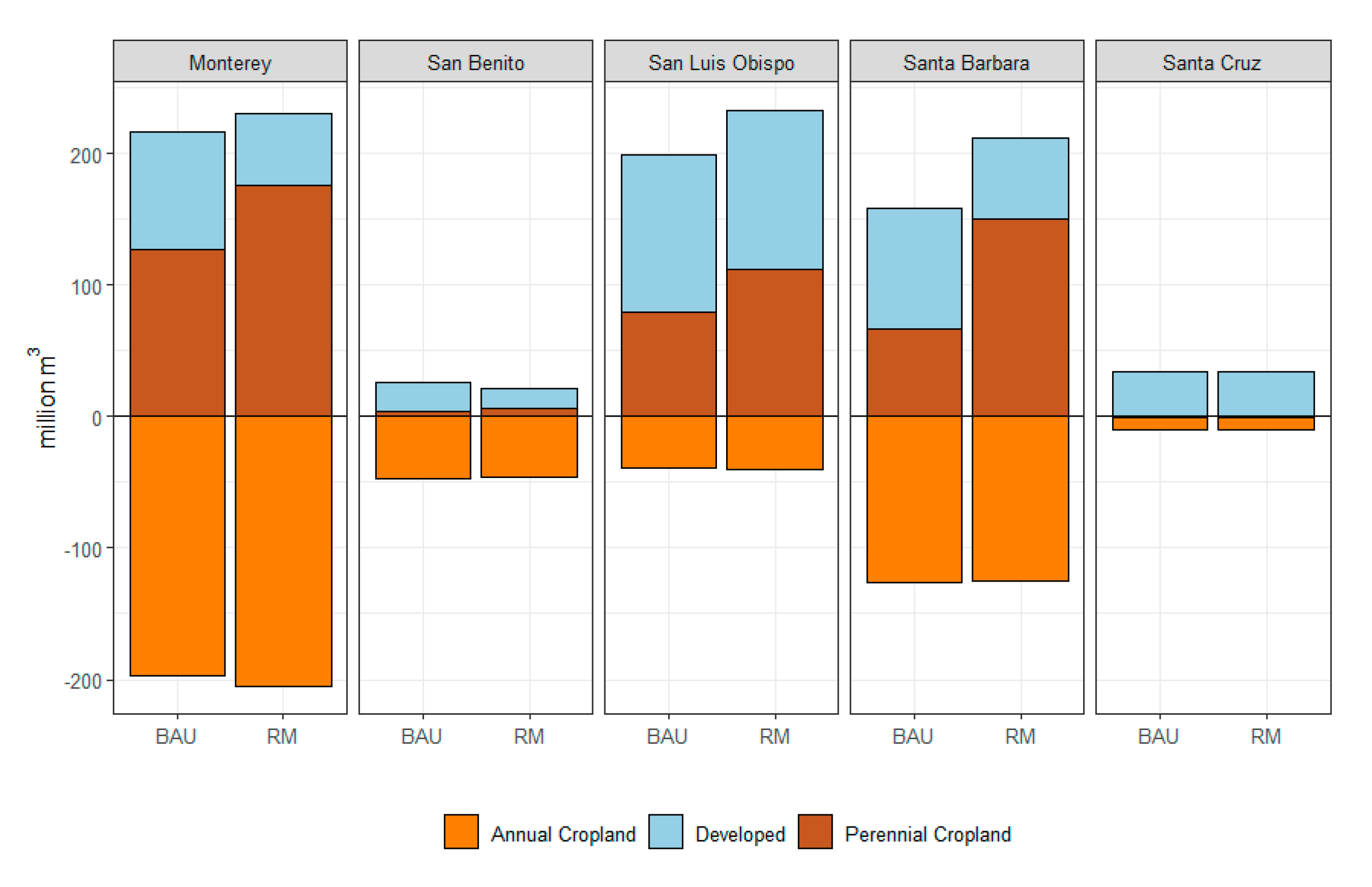
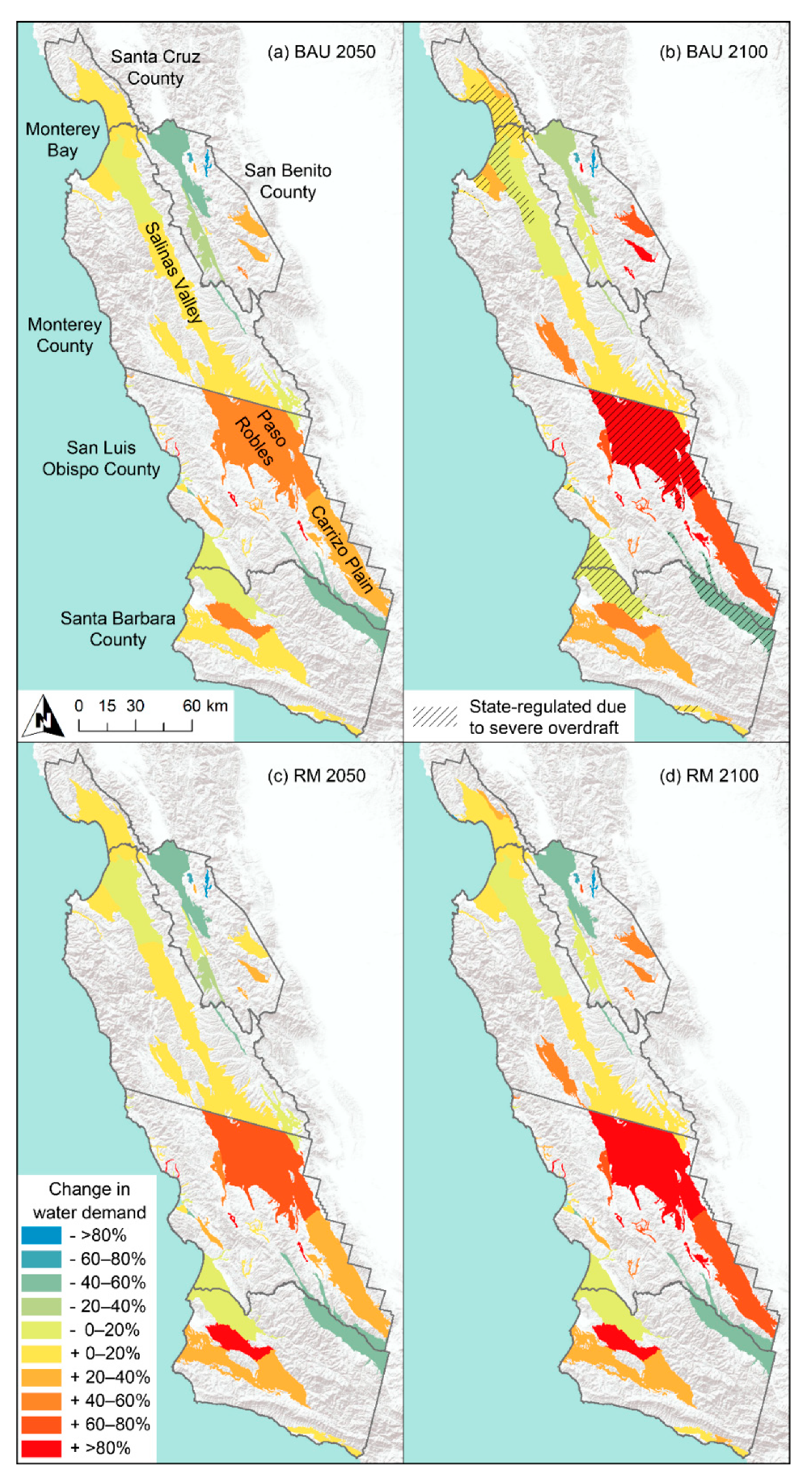
| Groundwater Sustainability Agency | BAU | RM | ||
|---|---|---|---|---|
| 2050 | 2100 | 2050 | 2100 | |
| Arroyo Seco GSA | −7.10 | −8.40 | −9.74 | −11.54 |
| Atascadero Basin GSA | 30.39 | 58.03 | 18.42 | 42.30 |
| City of Arroyo Grande GSA | 47.55 | 68.24 | 47.84 | 70.63 |
| City of San Luis Obispo GSA | 0 | 0 | 0 | 0 |
| Cuyama Basin GSA | 9.24 | 12.94 | 8.02 | 11.06 |
| Goleta Fringe GSA | −2.28 | −3.47 | −2.11 | −2.96 |
| Montecito Groundwater Basin GSA | 17.71 | 17.64 | 16.80 | 16.85 |
| Paso Basin—County of San Luis Obispo GSA | 6.77 | 10.57 | 6.90 | 10.07 |
| Salinas Valley Basin GSA | 23.43 | 19.88 | 26.72 | 24.11 |
| San Antonio Basin GSA | 15.49 | 17.01 | 15.66 | 18.82 |
| San Benito County Water District GSA | 8.61 | 11.06 | 7.63 | 11.06 |
| San Luis Obispo Valley Basin—County of San Luis Obispo GSA | 11.15 | 11.90 | 10.85 | 11.90 |
| Santa Maria Basin Fringe Areas—County of San Luis Obispo GSA | 9.24 | 9.81 | 9.14 | 10.03 |
| Santa Maria Basin Fringe in Santa Barbara County GSA | 1.51 | 1.51 | 1.51 | 1.51 |
| Santa Ynez River Valley Basin Central Management Area GSA | −4.15 | 0.38 | −5.53 | −2.87 |
| Santa Ynez River Valley Basin Eastern Management Area GSA | 9.52 | 11.37 | 8.64 | 11.37 |
| Santa Ynez River Valley Basin Western Management Area GSA | 53.43 | 76.80 | 53.13 | 77.10 |
| Shandon-San Juan GSA | 15.89 | 20.76 | 15.57 | 20.23 |
| City of Paso Robles | 12.50 | 14.09 | 12.23 | 14.37 |
| County of San Luis Obispo | 6 | 7.33 | 4.78 | 6.66 |
| County of Santa Cruz | 3.34 | 3.34 | 3.34 | 3.34 |
| Heritage Ranch Community Services District | 15.34 | 15.20 | 14.74 | 14.75 |
| Marina Coast Water District | 69.04 | 82 | 77.80 | 81.97 |
| Monterey Peninsula Water Management District | 44.75 | 40.83 | 84.96 | 102.01 |
| Pajaro Valley Water Management Agency | 9.79 | 10.38 | 9.49 | 10.38 |
| San Miguel Community Services District | 19.59 | 25.80 | 16.24 | 24.16 |
| Santa Clara Valley Water District | 178.78 | 383.94 | 157.66 | 374.79 |
| Santa Cruz Mid-County Groundwater Agency | 2.28 | 2.54 | 2.28 | 2.54 |
| Santa Margarita Groundwater Agency | 26.33 | 35.41 | 24.47 | 34.50 |
| Water District | BAU | RM | ||
|---|---|---|---|---|
| 2050 | 2100 | 2050 | 2100 | |
| Alco Water Service | −7.10 | −8.40 | −9.74 | −11.54 |
| Aromas Water District | 30.39 | 58.03 | 18.42 | 42.30 |
| Atascadero Mutual Water Company | 47.55 | 68.24 | 47.84 | 70.63 |
| CA Parks and Recreation Department—Hollister Hills SVRA | 0 | 0 | 0 | 0 |
| California American Water Company—Monterey District | 9.24 | 12.94 | 8.02 | 11.06 |
| California Water Service Company—Salinas | −2.28 | −3.47 | −2.11 | −2.96 |
| California Water Service Company—Salinas Hills | 17.71 | 17.64 | 16.80 | 16.85 |
| Cambria Community Services District | 6.77 | 10.57 | 6.90 | 10.07 |
| Carpinteria Valley Water District | 23.43 | 19.88 | 26.72 | 24.11 |
| Central Coast Water Authority | 15.49 | 17.01 | 15.66 | 18.82 |
| Central Water District | 8.61 | 11.06 | 7.63 | 11.06 |
| City of Arroyo Grande | 11.15 | 11.90 | 10.85 | 11.90 |
| City of Goleta | 9.24 | 9.81 | 9.14 | 10.03 |
| City of Grover Beach | 1.51 | 1.51 | 1.51 | 1.51 |
| City of Lompoc | −4.15 | 0.38 | −5.53 | −2.87 |
| City of Morro Bay | 9.52 | 11.37 | 8.64 | 11.37 |
| City of Paso Robles | 53.43 | 76.80 | 53.13 | 77.10 |
| City of Pismo Beach | 15.89 | 20.76 | 15.57 | 20.23 |
| City of San Luis Obispo | 12.50 | 14.09 | 12.23 | 14.37 |
| City of Santa Barbara | 6 | 7.33 | 4.78 | 6.66 |
| City of Santa Cruz | 3.34 | 3.34 | 3.34 | 3.34 |
| City of Watsonville | 15.34 | 15.20 | 14.74 | 14.75 |
| Golden State Water Company—Edna | 69.04 | 82 | 77.80 | 81.97 |
| Golden State Water Company—Lake Marie | 44.75 | 40.83 | 84.96 | 102.01 |
| Golden State Water Company—Los Osos | 9.79 | 10.38 | 9.49 | 10.38 |
| Golden State Water Company—Orcutt | 19.59 | 25.80 | 16.24 | 24.16 |
| Heritage Ranch Community Service District | 178.78 | 383.94 | 157.66 | 374.79 |
| Los Osos Community Services District | 2.28 | 2.54 | 2.28 | 2.54 |
| Montecito Water District | 26.33 | 35.41 | 24.47 | 34.50 |
| Monterey County Recycling Project | −7.06 | −16.89 | −6.74 | −16.49 |
| Oceano Community Service District | 5.20 | 5.81 | 5.40 | 5.60 |
| Other Small Additional District | 21.05 | 30.90 | 18.79 | 29.33 |
| Pajaro Community Service District | −8.23 | −13.46 | −9.60 | −17.05 |
| San Lorenzo Valley Water District | 4.46 | 5.46 | 4.05 | 5.46 |
| Santa Lucia Preserve Water System | 0 | 0 | 0 | 0 |
| Santa Maria Valley Water Conservation District | −22.80 | −37.25 | −27.00 | −37.78 |
| Scotts Valley Water District | 1.44 | 1.80 | 0.99 | 1.80 |
| Soquel Creek Water District | 4.38 | 4.38 | 4.38 | 4.38 |
| Templeton Community Services District | 58.51 | 73.66 | 54.91 | 73.19 |
| Unmanaged | −7.10 | −8.40 | −9.74 | −11.54 |
© 2020 by the authors. Licensee MDPI, Basel, Switzerland. This article is an open access article distributed under the terms and conditions of the Creative Commons Attribution (CC BY) license (http://creativecommons.org/licenses/by/4.0/).
Share and Cite
Wilson, T.S.; Van Schmidt, N.D.; Langridge, R. Land-Use Change and Future Water Demand in California’s Central Coast. Land 2020, 9, 322. https://doi.org/10.3390/land9090322
Wilson TS, Van Schmidt ND, Langridge R. Land-Use Change and Future Water Demand in California’s Central Coast. Land. 2020; 9(9):322. https://doi.org/10.3390/land9090322
Chicago/Turabian StyleWilson, Tamara S., Nathan D. Van Schmidt, and Ruth Langridge. 2020. "Land-Use Change and Future Water Demand in California’s Central Coast" Land 9, no. 9: 322. https://doi.org/10.3390/land9090322
APA StyleWilson, T. S., Van Schmidt, N. D., & Langridge, R. (2020). Land-Use Change and Future Water Demand in California’s Central Coast. Land, 9(9), 322. https://doi.org/10.3390/land9090322






